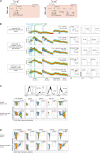Optimized Detection of Acute MHV68 Infection With a Reporter System Identifies Large Peritoneal Macrophages as a Dominant Target of Primary Infection
- PMID: 33767688
- PMCID: PMC7985543
- DOI: 10.3389/fmicb.2021.656979
Optimized Detection of Acute MHV68 Infection With a Reporter System Identifies Large Peritoneal Macrophages as a Dominant Target of Primary Infection
Abstract
Investigating the dynamics of virus-host interactions in vivo remains an important challenge, often limited by the ability to directly identify virally infected cells. Here, we utilize a beta-lactamase activated fluorescent substrate to identify primary targets of murine gammaherpesvirus 68 (MHV68) infection in the peritoneal cavity. By optimizing substrate and detection conditions, we were able to achieve multiparameter characterization of infected cells and the ensuing host response. MHV68 infection leads to a pronounced increase in immune cells, with CD8+ T cells increasing by 3 days, and total infiltrate peaking around 8 days post-infection. MHV68 infection results in near elimination of large peritoneal macrophages (LPMs) by 8 days post-infection, and a concordant increase in small peritoneal macrophages (SPMs) and monocytes. Infection is associated with prolonged changes to myeloid cells, with a distinct population of MHC IIhigh LPMs emerging by 14 days. Targets of MHV68 infection could be readily detected. Between 1 and 3 days post-infection, MHV68 infects ∼5-10% of peritoneal cells, with >75% being LPMs. By 8 days post-infection, the frequency of MHV68 infection is reduced at least 10-fold, with infection primarily in SPMs, with few infected dendritic cells and B cells. Importantly, limiting dilution analysis indicates that at 3 days post-infection, the majority of MHV68-infected cells harbor latent rather than lytic virus at frequencies consistent with those identified based on reporter gene expression. Our findings demonstrate the utility of the beta-lactamase MHV68 reporter system for high throughput single-cell analysis and identify dynamic changes during primary gammaherpesvirus infection.
Keywords: gammaherpesvirus; latency; macrophages; multiparameter flow cytometry; peritoneal cavity; reporter virus.
Copyright © 2021 Riggs, Medina, Perrenoud, Bonilla, Clambey, van Dyk and Berg.
Conflict of interest statement
DB was employed by company Cytek Biosciences. The remaining authors declare that the research was conducted in the absence of any commercial or financial relationships that could be construed as a potential conflict of interest.
Figures








Similar articles
-
Murine Gammaherpesvirus 68 Efficiently Infects Myeloid Cells Resulting In An Atypical, Restricted Form Of Infection.bioRxiv [Preprint]. 2023 Jun 29:2023.06.21.545948. doi: 10.1101/2023.06.21.545948. bioRxiv. 2023. PMID: 37425871 Free PMC article. Preprint.
-
LXR Alpha Restricts Gammaherpesvirus Reactivation from Latently Infected Peritoneal Cells.J Virol. 2019 Mar 5;93(6):e02071-18. doi: 10.1128/JVI.02071-18. Print 2019 Mar 15. J Virol. 2019. PMID: 30602604 Free PMC article.
-
Murine Gammaherpesvirus 68 Expressing Kaposi Sarcoma-Associated Herpesvirus Latency-Associated Nuclear Antigen (LANA) Reveals both Functional Conservation and Divergence in LANA Homologs.J Virol. 2017 Sep 12;91(19):e00992-17. doi: 10.1128/JVI.00992-17. Print 2017 Oct 1. J Virol. 2017. PMID: 28747501 Free PMC article.
-
Murine Gammaherpesvirus 68: A Small Animal Model for Gammaherpesvirus-Associated Diseases.Adv Exp Med Biol. 2017;1018:225-236. doi: 10.1007/978-981-10-5765-6_14. Adv Exp Med Biol. 2017. PMID: 29052141 Review.
-
Revisiting mouse peritoneal macrophages: heterogeneity, development, and function.Front Immunol. 2015 May 19;6:225. doi: 10.3389/fimmu.2015.00225. eCollection 2015. Front Immunol. 2015. PMID: 26042120 Free PMC article. Review.
Cited by
-
IKKα-Mediated Noncanonical NF-κB Signaling Is Required To Support Murine Gammaherpesvirus 68 Latency In Vivo.J Virol. 2022 May 25;96(10):e0002722. doi: 10.1128/jvi.00027-22. Epub 2022 Apr 28. J Virol. 2022. PMID: 35481781 Free PMC article.
-
The Application of Single-Cell Technologies for Vaccine Development Against Viral Infections.Vaccines (Basel). 2025 Jun 26;13(7):687. doi: 10.3390/vaccines13070687. Vaccines (Basel). 2025. PMID: 40733664 Free PMC article. Review.
-
Mouse Homologue of Human HLA-DO Does Not Preempt Autoimmunity but Controls Murine Gammaherpesvirus MHV68.J Immunol. 2021 Dec 15;207(12):2944-2951. doi: 10.4049/jimmunol.2100650. Epub 2021 Nov 22. J Immunol. 2021. PMID: 34810225 Free PMC article.
-
Preexisting helminth challenge exacerbates infection and reactivation of gammaherpesvirus in tissue resident macrophages.PLoS Pathog. 2023 Oct 17;19(10):e1011691. doi: 10.1371/journal.ppat.1011691. eCollection 2023 Oct. PLoS Pathog. 2023. PMID: 37847677 Free PMC article.
-
Development of Spectral Imaging Cytometry.Methods Mol Biol. 2023;2635:3-22. doi: 10.1007/978-1-0716-3020-4_1. Methods Mol Biol. 2023. PMID: 37074654 Review.
References
-
- Berger J. N., Sanford B., Kimball A. K., Oko L. M., Kaspar R. E., Niemeyer B. F., et al. (2020). Redefining de novo gammaherpesvirus infection through high-dimensional, single-cell analysis of virus and host. bioRxiv [Preprint]. 10.1101/2020.08.11.203117 - DOI
Grants and funding
LinkOut - more resources
Full Text Sources
Other Literature Sources
Research Materials

